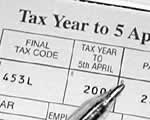 Go to main content
Go to main content
Archive Website of the UK government
Please note that this website has a UK government accesskeys system.
Main menu
Page menu
Money, tax and benefits

 Understanding your PAYE Coding Notice
Understanding your PAYE Coding Notice

Your 'PAYE Coding Notice' tells you what your tax code is and how it's worked out. The tax code tells your employer or pension provider what tax-free income you're entitled to (if any) over the tax year and, as a result, how much tax to take off your income before they pay you. This system of collecting tax is called PAYE (Pay As You Earn).
Your PAYE Coding Notice entries
Your PAYE Coding Notice entries fall into two key groups which together influence how much tax you will pay on your income.
Allowances and reliefs - positive amounts
These are shown as positive amounts and include:
- tax-free allowances (amounts of income that you're entitled to receive tax-free: Personal Allowance and Blind Person's Allowance)
added to
- other allowances or reliefs based on your individual circumstances - which reduces your tax bill if you're a taxpayer (for example Married Couple's Allowance, professional allowances/subscriptions)
If these are the only entries on your Coding Notice, they are deducted from your taxable income (employment, pension and any other earnings/income) and you pay tax on what's left.
Items that reduce your tax-free amount - negative amounts
You may also have negative amounts showing on your Coding Notice.
These are taken away from your allowances and reliefs. Items that reduce your tax-free amount may include:
- taxable income/state benefits/state or other pensions that you already receive without tax taken off, for example medical insurance or a company car
- taxable company benefits that you receive without tax taken off
- unpaid tax that you owe from an earlier tax year
Why items that reduce your tax-free amount are deducted from allowances
The total value of the items that reduce your tax-free amount is taken away from the total value of your allowances and reliefs in order to correct the balance between the following:
- the positive amounts - what income you're entitled to receive without paying tax
- the negative amounts - what you've already received or are already receiving without tax taken off
By subtracting the items that reduce your tax-free amount HM Revenue & Customs (HMRC) tries to make sure that you pay the right amount of tax during the tax year.
Effect of deductions from allowances
After the deductions are taken away from your allowances, there are three possibilities.
If the items that reduce your tax-free amount are less than your allowances
In this case the amount left is income you can still receive tax-free in this tax year. This amount will be taken away from your overall taxable income and you pay tax on the balance.
If the items that reduce your tax-free amount are equal to your allowances
In this case you don't have any tax-free allowances to set against your taxable pay for the year - so you pay tax on all of your taxable income.
If the items that reduce your tax-free amount are greater than your allowances
In this case your allowances are all used up and you will owe tax on the difference between the two. For example, if your allowances are £6,000 and your deductions work out at £6,250 you will owe tax on £250. This amount will be added to your overall taxable income and you'll pay tax on the total proportionately over the year. (HMRC indicate that your allowances are used up and you owe extra tax by giving you a 'K code'.)
If your income is above £150,000
Since the 2010-11 tax year an additional tax rate of 50 per cent tax rate applies to individuals with taxable income above £150,000. During 2010-11 HMRC didn’t issue revised tax codes to amend ‘reliefs and adjustments’ if you were due to pay tax at 50 per cent for the 2010-11 tax year.
HMRC will work out how much tax you are actually due to pay when you send in your 2010-11 Self Assessment tax return. This may mean you'll owe some extra tax or you'll be due a refund.
Tax codes from 2011-12 take into account the 50 per cent tax rate and any ‘reliefs and adjustments’.
What do you need to do with your PAYE Coding Notice?
Your Coding Notice is yours to keep. HMRC tells your employer or pension provider what your tax code is. If you have an agent or tax adviser acting for you, HMRC suggests you show them a copy of your Coding Notice.
If your PAYE Coding Notice contains wrong information
If you think that any of the information on your PAYE Coding Notice is wrong (for example, because your circumstances or income have changed, or HMRC has made a mistake) please contact HMRC. If the amounts are incorrect you could end up paying too much or too little tax. You'll find the contact details for HMRC on your Coding Notice.
You can also search for them online below. If anything is incorrect HMRC issues a new Coding Notice and tax code.
Please contact HMRC if you need further explanation of any of the figures on your Coding Notice.
Provided by HM Revenue and Customs
In this section...
- Tax codes - the basics
- Common PAYE Coding Notice entries explained
- Emergency tax codes
- Company benefits in your tax code
- Expense payments in your tax code
- Pensions, state benefits and your tax code
- Other income taxed through your tax code
- How underpayments of tax affect your tax code
- If you have more than one tax code
 Facebook
Facebook Twitter
Twitter StumbleUpon
StumbleUpon Delicious
Delicious Reddit
Reddit